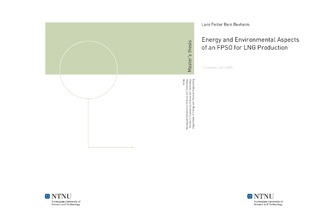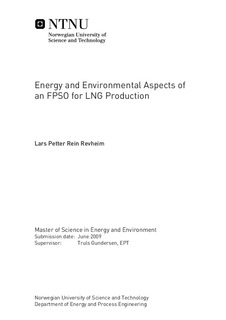| dc.contributor.advisor | Gundersen, Truls | nb_NO |
| dc.contributor.author | Revheim, Lars Petter Rein | nb_NO |
| dc.date.accessioned | 2014-12-19T11:46:19Z | |
| dc.date.available | 2014-12-19T11:46:19Z | |
| dc.date.created | 2011-06-27 | nb_NO |
| dc.date.issued | 2009 | nb_NO |
| dc.identifier | 426919 | nb_NO |
| dc.identifier | ntnudaim:4683 | nb_NO |
| dc.identifier.uri | http://hdl.handle.net/11250/234236 | |
| dc.description.abstract | The floating production unit HLNG FPSO-1 has been evaluated with respect to its energy consumption and emissions to air, and improvement potentials within the same context have been suggested. The thesis describes theory of combustion of natural gas, emission calculations, energy consumption of compressors and theory of fuel gas consumption for gas turbines. A literature study of LNG processes suitable for offshore applications has also been included. The CO2 emissions from the HLNG FPSO-1 add up to about 6% of the CO2 emissions from the Norwegian oil and gas industry (2005), which is a noticeable amount. However the energy content in the LNG produced over one year from the FPSO-1 count for ca 35% of the yearly energy consumed related to oil and gas extraction on the Norwegian continental shelf. This illustrates that even though floating LNG production is energy intensive and the resulting amounts of greenhouse gas emissions (as CO2) are substantial, the LNG holds significant amounts of energy, which is a result of the 600-fold reduction in volume when the natural gas is liquefied. Two different availabilities of the topside processes FPSO-1 exist and are calculated by Det Norske Veritas. The lower availability is based on a no-flare philosophy, which is considered not to be relevant for the project in the further development. The reason for this is that a strict no-flaring philosophy is not desirable from an operational point of view, and that duplication of every equipment item which handles hydrocarbon streams is not a realistic design alternative. Therefore the higher availability which allows some flaring during normal production is used for all the suggested improvement potentials. Based on two different future oil prices (a high and low scenario), the value of the LNG produced, as well as the value of the additional LNG produced as a result of higher availability of the FPSO-1 are calculated. Two design changes of the LNG liquefaction process as a result of a lighter feed gas composition are described and discussed in the context of energy consumption and emissions to air. Both design changes have the possibility of saving more than 10 MW power in total. Also, the implications of eventual necessary compliance with the Equator Principles are discussed. The project may find that certain guidelines or philosophies given by institutions financing parts of the project must be followed (such as use of Best Available Technology), and should evaluate these eventual restrictions when financial institutions are selected for the project. The further development of the project with the goal of making the topside processes on the FPSO-1 as energy efficient as possible (thereby saving operational costs and reducing the impact on the environment), should evaluate the feasibility of implementing the design changes suggested in the thesis from a more extensive technical and economical point of view. | nb_NO |
| dc.language | eng | nb_NO |
| dc.publisher | Institutt for energi- og prosessteknikk | nb_NO |
| dc.subject | ntnudaim:4683 | no_NO |
| dc.subject | MIENERG energibruk og energiplanlegging | no_NO |
| dc.subject | Energibruk og energiplanlegging | no_NO |
| dc.title | Energy and Environmental Aspects of an FPSO for LNG Production | nb_NO |
| dc.type | Master thesis | nb_NO |
| dc.source.pagenumber | 77 | nb_NO |
| dc.contributor.department | Norges teknisk-naturvitenskapelige universitet, Fakultet for ingeniørvitenskap og teknologi, Institutt for energi- og prosessteknikk | nb_NO |

